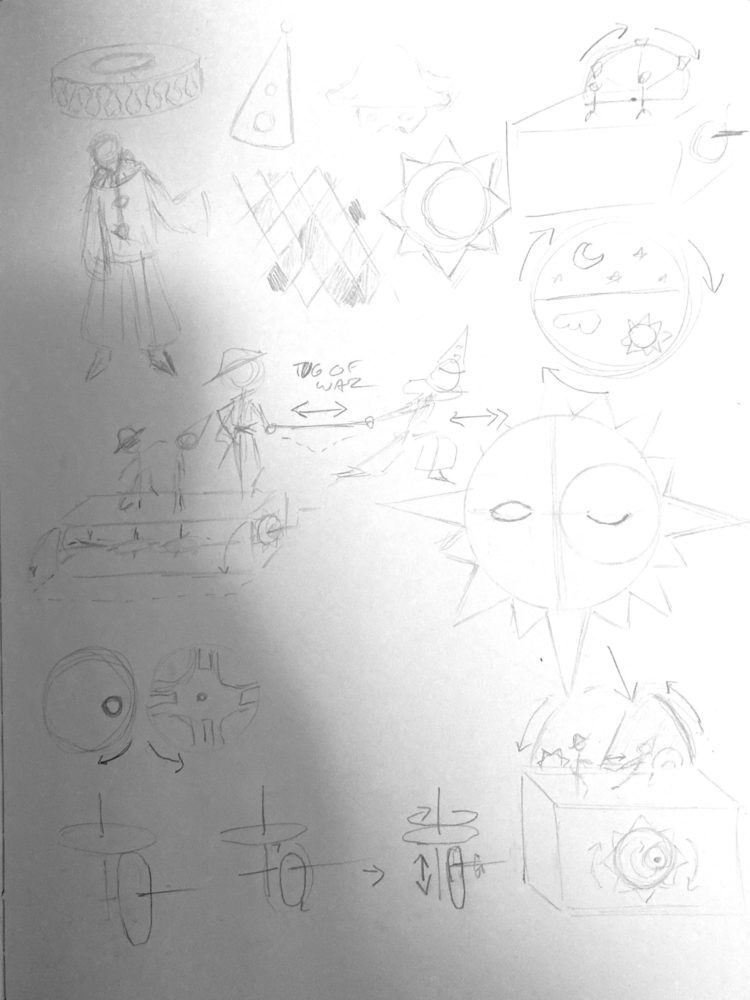The aesthetic I decided to pursue was Clowncore, which on the Aesthetics Wiki, is defined as “(also known as circuscore or clownpunk) surrounds things such as clowns, mimes, and jesters.” Common themes found in this aesthetic are circuses, tents, carnivals, and more whimsical items like toys or candy. However, instead of the more modern clowncore, I have decided to base my designs off of older concepts, specifically those of Pierrot and Harlequin. Originally from Commedia dell’arte, both Pierrot and Harlequin are “Zanni” or clowns within the performances, however, Harlequin takes on more of a trickster role while Pierrot takes a sadder, almost pity-humor role. Both of the clowns have very distinct designs, Harlequin with a complicated almost-quilted patterned suit, while Pierrot sports a larger, white and baggy suit. Below is a fairly accurate painting of the two Zanni together.
 J.C. Leyendecker has several examples of clowns that he was drawn, specifically for the Saturday Evening Post Covers, including “Circus Dog” and “Carnival.”
J.C. Leyendecker has several examples of clowns that he was drawn, specifically for the Saturday Evening Post Covers, including “Circus Dog” and “Carnival.”

 More modern examples of these two include character Harley Quinn from “Batman: The Animated Series” and while this is not a strict translation of the harlequin style, it certainly made the style more popular and known. One of the most recent examples of Pierrot costume outside of specific theater, was Mike Geier, otherwise known as Puddle Pity Party 7-foot-tall opera singer that dresses up like a clown on stage.
More modern examples of these two include character Harley Quinn from “Batman: The Animated Series” and while this is not a strict translation of the harlequin style, it certainly made the style more popular and known. One of the most recent examples of Pierrot costume outside of specific theater, was Mike Geier, otherwise known as Puddle Pity Party 7-foot-tall opera singer that dresses up like a clown on stage.
 For my upcycling project, the medium I chose was cardboard, which is very versatile and can be used in pretty much any fashion depending on what type you have. I have been collecting pieces over the past couple weeks to give myself an ample selection (mostly from packages I have received and my office’s recycling cart.)
For my upcycling project, the medium I chose was cardboard, which is very versatile and can be used in pretty much any fashion depending on what type you have. I have been collecting pieces over the past couple weeks to give myself an ample selection (mostly from packages I have received and my office’s recycling cart.)
For what I actually want to build, I have decided that I want to build an automaton of a scene featuring Pierrot and Harlequin. I checked several books and sources online to try and see what sort of motion I wanted to have, unfortunately, I gave myself too many options, so I decided to try and find a design I liked then model the mechanism around it. Below is a page of sketches I did including overarching themes and motifs I want in the piece, as well as several iterations of what sort of automaton I want to build.

In the end, I decided that the machine would be a tug of war between Pierrot and Harlequin, Pierrot struggling to win, while Harlequin finding it comically easy. I looked through several tug of war automatons online, including several on youtube which I will link below.
I finally came across a mechanism I liked, not from a tug of war machine, but actually a lego assembly line of Christmas elves. However it used a two-way linear motion switch, so I had to find a suitable translation for rotational motion into linear motion.
I will probably paint the final product with a set of POSCA Paint Pens that I own, as I have also challenged myself to not buy anything for this project (I accidentally cheated already… grabbing a set of exacto blades at the hardware store. Whoops. But I won’t slip up again.) I will have to be careful painting, so as to not oversaturate the cardboard and make it pill.
Citations:
Brickworks, JK, director. Elf Workshop Kinetic Lego Model, YouTube, 23 Nov. 2018, https://www.youtube.com/watch?v=7pWd9_VpZgk&ab_channel=JKBrickworks. Accessed 9 Feb. 2023.
Cezanne, Paul. Pierrot and Harlequin. 1888, The Pushkin State Museum of Fine Arts, St. Petersberg, Russia.
“Clowncore.” Aesthetics Wiki, https://aesthetics.fandom.com/wiki/Clowncore.
“Commedia Dell’arte.” Wikipedia, Wikimedia Foundation, 6 Feb. 2023, https://en.wikipedia.org/wiki/Commedia_dell%27arte#Characters.
Douglas, Tim, director. Tug of War, YouTube, 12 June 2008, https://www.youtube.com/watch?v=dWpplHMloQE&ab_channel=timdouglas. Accessed 9 Feb. 2023.
“Harley Quinn.” Batman, https://batmantheanimatedseries.fandom.com/wiki/Harley_Quinn.
Leyendecker, J.C. “Artworks Archive: Page 17 of 282.” The Saturday Evening Post, 31 Dec. 1932, https://www.saturdayeveningpost.com/artworks/page/17/?artwork-artist=j-c-leyendecker&artwork-year&artwork-theme.
“Mike Geier.” Wikipedia, Wikimedia Foundation, 28 Jan. 2023, https://en.wikipedia.org/wiki/Mike_Geier.
Waghorm, Grahame, director. Tug O Love – Automaton, YouTube, 10 June 2022, https://www.youtube.com/watch?v=8aylFQ4NbrQ&ab_channel=GrahameWaghorn. Accessed 9 Feb. 2023.

2 Comments. Leave new
Hi Lily, I love your choice of aesthetic! Choosing to portray two classic characters that are part of the Clowncore aesthetic makes the background behind the project very interesting. What did you end up deciding to use to translate rotational motion to linear motion? The mechanism behind your project is also very interesting.
Hi Alex, I decided to use a scotch yoke system to save on space.